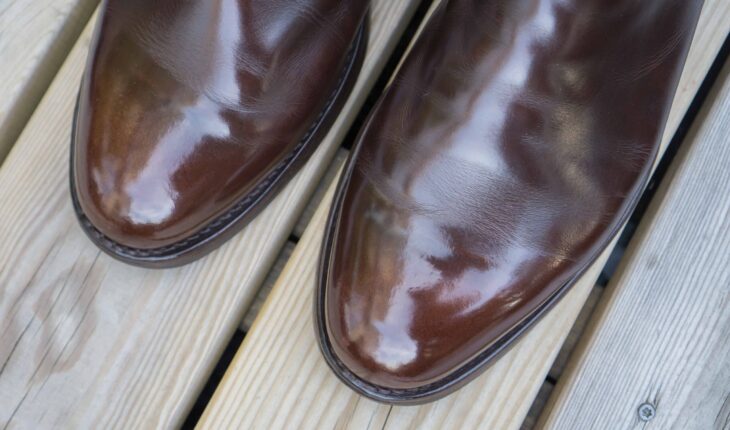When smooth leather or embossed grain leathers and similar are bent it will crease, it’s the nature of this material. And this creasing can’t be removed, despite what many out there say. Here I explain the logical physics behind why shoes crease and why you can’t remove them more than temporarily.
To understand how creases of leather works, we start with this classic image of the different sections of a leather, used here on Shoegazing before, explaining the different parts of the leather.


A hide, when seen in split through so to speak, consists of two main parts, the grain with very dense collagen fibres, and the corium, with very loose collagen fibres, and in between there’s the junction where the fibres goes from dense to loose. (Original source of the pic is unknown, it’s used by loads of different sites in various versions nowadays.)


Here’s the same thing but with a photo of a real piece of a tanned hide. Picture (modified by me): Mr. Lentz
The finest and most expensive type of smooth pressed leather is full grain leather, which consists of the whole grain part and the junction and perhaps some of the corium as well, with the junction/top part of the corium being pressed together usually with a cross/hatch pattern which makes it look almost like a fabric on the back. To be able to use the actual grain surface the quality of the leather needs to be good.
Then there’s a number of other types of leathers, like embossed grain leather, top grain leather, “genuine leather”, corrected grain leather and so on, many of them who only use part of the hide, change or add things etc. While most of these who all have the denser grain side outwards (even if it’s in some cases sanded down to a certain degree) and also have the same preferences when it comes to creasing (usually they crease much more though), here focus is on smooth full grain leather and embossed grain leather where the whole grain part is kept just pressed together. These are the most natural finishes and the leather works in the same way, even if of course how it creases and how the creases look may vary a lot also within these categories. We also won’t go too much into suede or roughout, only touch it a bit.
Why leather creases
Smooth full grain leather or embossed grain leather has the most dense part of the material outwards, this means that you have a strong and naturally protective barrier towards the elements. You can protect this further with for example wax, to achieve a great all natural durable material, and don’t need to use for example waterproofing spray to protect it (as I’ve written about in this article, you should in fact avoid using waterproofing spray on these leathers, that’s for suede, roughout or nubuck who don’t have the dense grain). Smaller marks etc. on the grain surface can also be restored with pigmented shoe cream. A lot of good pros.
However, given that it has the dense part outwards, this part of the material also can’t go anywhere when bent. To try to explain it as simply as possible, the leather is trapped between three hard places: the toe cap in the front, the instep in the back, and the foot below. When you bend the foot, as you inevitably will do when you walk, the leather has nothing to do but crease. The dense grain folds in these sometimes small fine creases, sometimes thicker deeper creases, sometimes like with Shell cordovan it rolls, but all these are just different ways of solving the matter of the material having nowhere to go when being bent. The closer the shoes fit the feet, without of course being too tight causing discomfort, the less material you have that needs to be folded.


When full grain leather shoes are bent over the vamp, the dense grain can’t go anywhere but fold into creases. Picture: Wishoeguy
The reason that for example suede leather doesn’t crease to the same extent, is that there you have the most dense part of the material at the bottom, so to speak, and the looser corium (look at the pictures above) can wrap around the denser part. You often get light streaks in it when the nappy looser parts is pressed against each other, and / or some rolls, but not actual creases.
What happens when leather creases
Now you know why full grain leather creases, let’s go into what actually happens in the material. When the leather is forced to fold itself into creases, the fibre structure of the material is “broken” and it gets soft and pliable in certain areas, areas that makes it fold into the creases that you will see. Already the first steps you take with a pair of shoes decides a lot of how it will end up creasing (which is why it can be good to place the creases yourself, which I write about in this article). Once the fibres of the leathers has been broken into creases it will continue to try to fold in the same places, since it’s less force needed to bend there. New creases can of course fold when needed to, and often will to a certain degree, and with time everything will slowly become more pronounced. But when it comes to the creasing shoes will look more similar between day 20 and day 200 of wear, than between being unworn and day 20 of wear.


Since the creases that are formed in shoes during the first few steps settle a lot of how it will continue to crease, it can be good to place the creases, for example with the help of pencils.
Why you can’t remove creases from leather
Online you will find plenty of info on how you can remove creases of leather, which usually involves water and / or heat. You’ll see great before and after footage that shows how the leather has been smoothened out again, it can look really neat. Often it is mentioned that the leather will crease again when used, but that you are given the impression that you sort of can start over again. This is not the case. Yes, you can smoothen out leather creases, they can disappear visually. But the leather fibres are still broken, and what will happen when the shoes are worn is that the leather will start to fold and crease again in the exact same area as before, since again, there is less force needed to fold here.


How it often looks in guides on how to remove creases. Picture: The Spruce
So basically nothing changes more than temporarily. And since the process of removing creases with the heat can be quite stressing on the material, and worst case even damage it, it’s important that people know this. If you still think it’s worth it to go through the process for some reason, all good, but you should know that you won’t change anything in the long run (similar processes goes for shrinking leather, only works temporarily, it will stretch back). Full grain leather will always crease, and you will never be able to undo it more than for a little while.
With all the above said, still worth it to again highlight that it’s highly recommended to use wooden shoe trees to stretch out the soles and bring back the shape of the shoes. This will reduce how heavy the creases become, and together with regular nourishing from shoe care products it make the shoes look nicer through the years, and it will prolong the time it will take before the creases go so deep that the leather cracks, hopefully to far, far off in the future.






